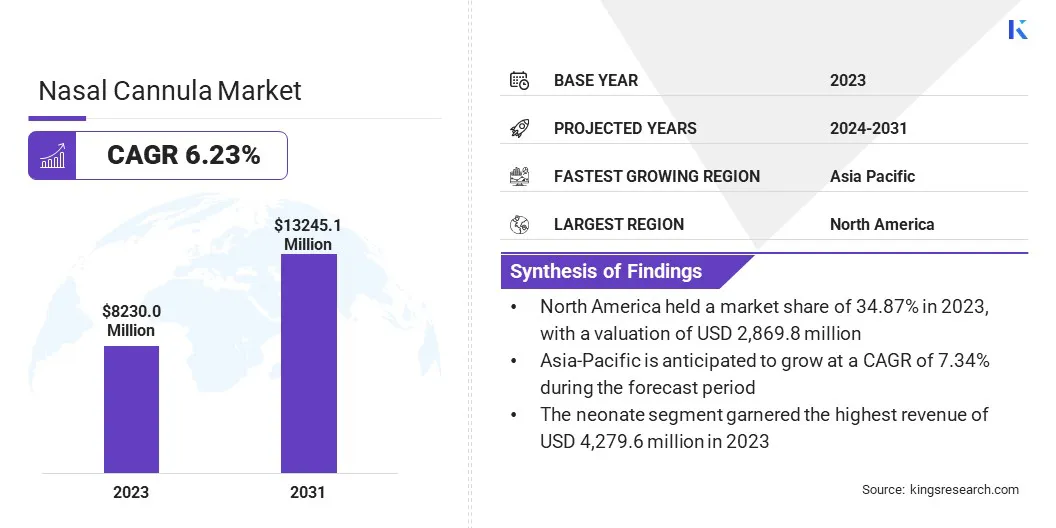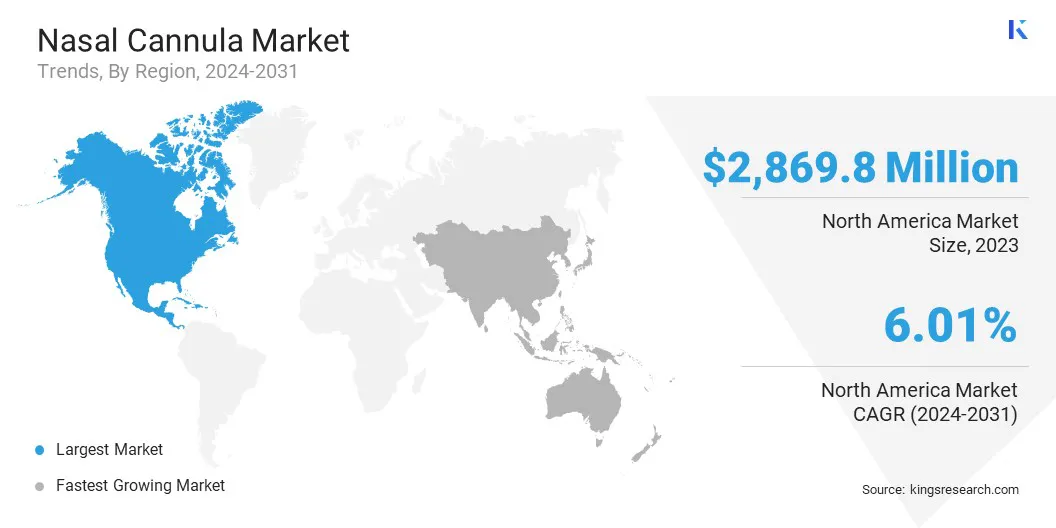Nasal Cannula Market Size
The global Nasal Cannula Market size was valued at USD 8,230.0 million in 2023 and is projected to grow from USD 8,676.2 million in 2024 to USD 13,245.1 million by 2031, exhibiting a CAGR of 6.23% during the forecast period. In the scope of work, the report includes products offered by companies such as Hamilton Medical, ResMed, TNI Medical AG, Teleflex Incorporated, Vapotherm, Flexicare (Group) Limited, Fairmont Medical, Fisher & Paykel Healthcare Limited., Fleming Medical Ltd, Medline Industries, LP and others.
The expansion of the market is driven by technological advancements in high-flow and smart devices, catering to increasing respiratory care needs globally. Rising prevalence of chronic respiratory diseases and a growing preference for home-based healthcare solutions further fuel market growth, reflecting a notable shift toward enhanced patient comfort and clinical efficacy.
The nasal cannula market is witnessing rapid growth, mainly due to advancements in technology and increasing demand for respiratory care solutions worldwide. Key innovations include high-flow and smart nasal cannulas with integrated monitoring systems, thereby enhancing patient comfort and clinical efficacy. Rising prevalence of chronic respiratory diseases, such as COPD and asthma, alongside aging populations, further propel market expansion.
Moreover, there is a growing preference for home-based healthcare solutions, thereby boosting the adoption of portable and user-friendly nasal cannulas. These trends reflect a shift toward personalized patient care and improved quality of life, underscoring the market's dynamic evolution in respiratory health management.
- In 2022, the CDC reported that 4.6% of adults diagnosed with COPD, emphysema, or chronic bronchitis. Additionally, 791,000 emergency department visits were recorded with COPD as the primary diagnosis.
A nasal cannula is a medical device designed to deliver supplemental oxygen or airflow to patients with respiratory issues. It consists of a lightweight tube with two small prongs that fit into the nostrils, allowing oxygen to be delivered directly into the nasal passages. This method is highly preferred for its comfort and ease of use, making it suitable for both short-term and long-term oxygen therapy in hospitals, clinics, and home settings. Nasal cannulas are crucial in managing conditions such as COPD, asthma, and respiratory distress.

Analyst’s Review
The growth of the market is fostered by advancements such as the proven efficacy of Positive Airway Pressure (PAP) therapy in reducing mortality and hospitalization risks among obstructive sleep apnea (OSA) patients.
- With the projected increase in the prevalence of OSA , particularly among adults aged 30-70 in the United States, there is a growing demand for effective respiratory support solutions such as nasal cannulas.
Key market players are strategically innovating by collaborating with scientists to develop specialized nasal cannula technologies. They focus on enhancing patient adherence through integrated monitoring systems and user-friendly designs, leveraging real-world data insights to optimize therapeutic outcomes and stimulate market expansion.
What are the major factors affecting the Nasal Cannula market?
The increasing prevalence of chronic respiratory diseases such as COPD and asthma has fueled the demand for nasal cannulas. These conditions, exacerbated by several factors such as aging populations and environmental pollutants, necessitate long-term oxygen therapy to manage symptoms and improve patient quality of life.
Nasal cannulas offer a non-invasive and efficient method for delivering supplemental oxygen, making them essential in respiratory care. This rising demand reflects a growing awareness of respiratory health needs and underscores the pivotal role of nasal cannulas in providing effective treatment options for patients suffering from chronic respiratory ailments, thereby aiding market growth.
- According to the World Health Organization (WHO), COPD is ranked as the seventh leading cause of global disability-adjusted life years (DALYs), highlighting its significant impact on public health worldwide. The burden of COPD is particularly pronounced in low- and middle-income countries (LMICs), where nearly 90% of COPD-related deaths in individuals under 70 years old occur.
However, the nasal cannula market faces several challenges due to the high cost associated with advanced devices, which limits widespread adoption, especially in low-income regions. These sophisticated technologies, including high-flow and smart nasal cannulas with integrated monitoring systems, offer significant therapeutic benefits.
However, their adoption presents a financial challenge for many healthcare facilities and patients. To address this obstacle, key market players are investing heavily in cost-effective manufacturing processes and forging partnerships with healthcare providers and governments to negotiate subsidies and bulk purchase agreements. They further offer flexible financing options and educational initiatives to raise awareness, aiming to make advanced nasal cannulas more accessible and affordable globally.
Which technological trends are shaping the market?
The progress of the nasal cannula market is propelled by recent advancements in technology, including high-flow nasal cannulas that improve patient comfort and respiratory support by delivering oxygen at elevated rates with precise humidification. These are particularly favored in critical care settings for acute respiratory needs.
Additionally, smart nasal cannulas with integrated monitoring systems continuously assess vital signs such as oxygen saturation and respiratory rate in real-time. This capability enables early detection of changes in patient condition, allowing healthcare providers to intervene promptly, thereby improving clinical outcomes and enhancing patient safety in the management of respiratory conditions.
There is a growing preference for home-based healthcare solutions, leading to an increasing adoption of portable and user-friendly nasal cannulas. Patients suffering from chronic respiratory conditions such as COPD and asthma are increasingly favoring the convenience and comfort associated with managing their treatment at home. Portable nasal cannulas allow them to maintain mobility while receiving necessary oxygen therapy, thereby enhancing their quality of life.
These devices are designed for user-friendly operation, featuring lightweight materials and ergonomic designs that cater to patients' comfort and ease of use. This trend reflects a broader shift towards patient-centric care models that prioritize convenience and independence in healthcare delivery, which is slated to stimulate market expansion.
Segmentation Analysis
The global market is segmented based on size, prongs, type, and geography.
How big is the neonate segment in this market?
Based on size, the nasal cannula market is categorized into neonate, infant, child, and adult. The neonate segment garnered the highest revenue of USD 4,279.6 million in 2023. Advancements in neonatal care have increased the survival rates among premature infants and those with respiratory distress syndrome, thereby expanding the patient pool requiring respiratory support.
Additionally, there is a growing emphasis on personalized healthcare solutions, prompting healthcare facilities to invest in specialized equipment such as neonatal nasal cannulas that ensure gentle and effective oxygen delivery. The rising prevalence of conditions necessitating respiratory support in newborns further boosts demand for these devices, fostering innovation and expansion of the critical healthcare segment.
What is the market share of the curved prongs segment?
Based on prongs, the market is divided into straight, curved, flared, and others. The curved segment captured the largest nasal cannula market share of 38.56% in 2023 as it caters to patients requiring prolonged oxygen therapy by offering enhanced comfort and efficiency. These nasal cannulas feature a curved or angled design that reduces pressure points and discomfort, particularly around the ears and face, making them ideal for long-term use.
Healthcare providers favor curved nasal cannulas for patients with chronic respiratory conditions such as COPD, as well as those recovering from surgeries. This design ensures a secure fit and proper oxygen delivery, thereby enhancing patient compliance and satisfaction. Widespread adoption of these nasal cannulas in both clinical settings and home care further support the expansion of the segment.
What will the market size for low flow segment by 2031?
Based on type, the market is categorized into low flow and high flow. The low flow segment is expected to garner the highest revenue of USD 8,165.9 million by 2031, as it focuses on delivering supplemental oxygen at rates typically up to 6 liters per minute. These devices are essential for patients with mild to moderate respiratory conditions, providing effective oxygen therapy while allowing for comfortable breathing.
Low-flow nasal cannulas are increasingly preferred for their simplicity, lightweight design, and cost-effectiveness compared to high-flow alternatives. They are widely used in clinical settings for conditions such as mild COPD exacerbations, asthma management, and post-operative recovery. Despite their basic functionality, low-flow nasal cannulas play a critical role in respiratory care, maintaining significant demand due to their practicality and widespread application.
What is the market scenario in North America and Asia-Pacific region?
Based on region, the global market is classified into North America, Europe, Asia-Pacific, MEA, and Latin America.

The North America nasal cannula market share stood around 34.87% in 2023 in the global market, with a valuation of USD 2,869.8 million. This considerable expansion is fostered by the high prevalence of chronic respiratory diseases such as COPD and asthma, highlighting the pressing need for the use of respiratory support devices.
The region's advanced healthcare infrastructure and stringent regulatory standards facilitate the rapid adoption of innovative nasal cannula technologies. An aging population further fuels regional market growth, leading to increased demand for effective respiratory care solutions.
Moreover, trends towards home healthcare and patient-centered care contribute to the popularity of portable and user-friendly nasal cannulas in the region. These factors collectively underscore North America's significant influence in shaping advancements and stimulating expansion.
Asia-Pacific is anticipated to witness the highest growth, recording a CAGR of 7.34% over the forecast period. The region is rapidly expanding its presence in the nasal cannula market due to rapid urbanization, a growing middle-class population, and rising healthcare expenditures. The prevalence of chronic respiratory diseases, influenced by environmental factors and shifting lifestyles, fuels the demand for respiratory care solutions, including nasal cannulas.
Advancements in healthcare infrastructure and increased awareness regarding respiratory health contribute to the widespread adoption of advanced medical devices. Government initiatives aimed at enhancing healthcare accessibility and affordability further support domestic market growth.
Competitive Landscape
The nasal cannula market report will provide valuable insight with an emphasis on the fragmented nature of the industry. Prominent players are focusing on several key business strategies such as partnerships, mergers and acquisitions, product innovations, and joint ventures to expand their product portfolio and increase their market shares across different regions.
Companies are implementing impactful strategic initiatives, such as expanding services, investing in research and development (R&D), establishing new service delivery centers, and optimizing their service delivery processes, which are likely to create new opportunities for market growth.
Key Companies in Nasal Cannula Market
The global nasal cannula market is segmented as:
By Size
- Neonate
- Infant
- Child
- Adult
By Prongs
- Straight
- Curved
- Flared
- Others
By Type
By Region
- North America
- Europe
- France
- U.K.
- Spain
- Germany
- Italy
- Russia
- Rest of Europe
- Asia-Pacific
- China
- Japan
- India
- South Korea
- Rest of Asia-Pacific
- Middle East & Africa
- GCC
- North Africa
- South Africa
- Rest of Middle East & Africa
- Latin America
- Brazil
- Argentina
- Rest of Latin America


